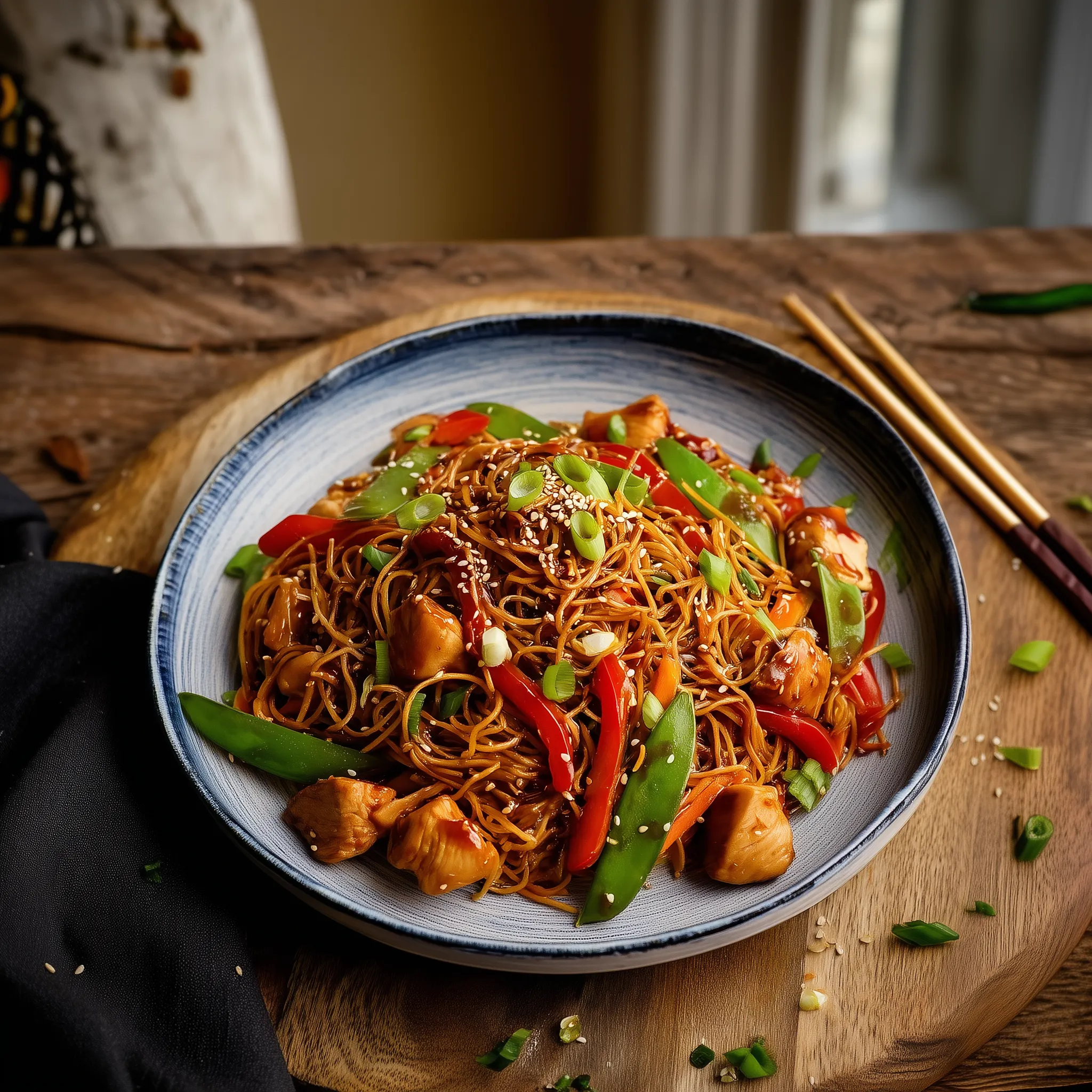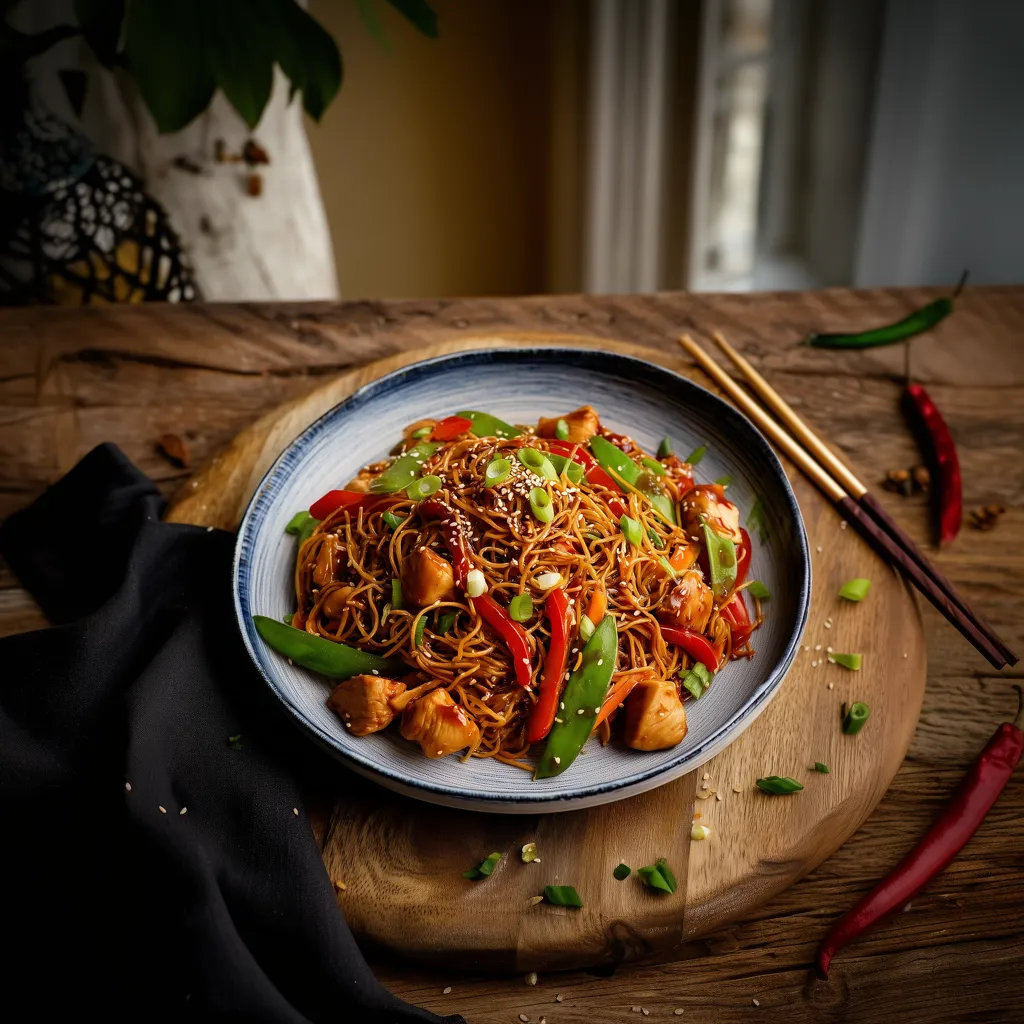 Save
Save
This quick and easy Chicken Lo Mein has become my weeknight dinner salvation. When my family craves something better than takeout but I have limited time, this noodle dish delivers restaurant-quality flavor with minimal effort.
I first started making this lo mein when my children began requesting Chinese takeout multiple times a week. After perfecting this recipe, they actually prefer my homemade version over delivery and now request it at least once every week.
Ingredients
- Dried fine egg noodles provide the perfect chewy texture and absorb all the delicious sauce
- Chicken breasts cut into bite sized chunks cook quickly and stay tender
- Onions and garlic create an aromatic flavor base that infuses the entire dish
- Carrots sliced into matchsticks add sweetness and satisfying crunch
- Red pepper brings bright color and vitamin C to the dish
- Sugar snap peas provide fresh green crunch and natural sweetness
- Spring onions add bright onion flavor without being overpowering
- Oyster sauce delivers that authentic umami richness essential for lo mein
- Soy sauce brings saltiness and depth of flavor
- Kecap manis adds caramel sweetness that balances the savory elements
- White pepper provides a distinctive earthy heat that black pepper cannot replicate
Step-by-Step Instructions
- Cook the Noodles
- Boil the egg noodles for just 3-4 minutes until barely tender. The crucial step here is rinsing them in cold water after draining. This stops the cooking process and prevents them from becoming a gummy mass while you prepare the rest of the dish.
- Sear the Chicken
- Heat your oil until shimmering but not smoking. Add chicken pieces without overcrowding the pan and let them cook undisturbed for about 2 minutes before stirring. This creates better browning and flavor development. Continue cooking until no pink remains, about 5-6 minutes total.
- Soften the Onions
- Add sliced onions to the chicken and stir frequently for two minutes. Look for the onions to become slightly translucent around the edges but not fully soft. This partial cooking ensures they maintain some texture in the final dish.
- Add Vegetables
- Incorporate garlic first, stirring constantly for 30 seconds until fragrant. Then add carrots, peppers, sugar snap peas and spring onions all at once. Keep everything moving quickly in the wok to ensure even cooking while maintaining crispness. One minute is all these vegetables need at this stage.
- Combine and Finish
- Add the cooked noodles and pour all sauce ingredients directly into the wok. Use tongs or two spatulas to lift and toss everything together, ensuring sauce coats all ingredients evenly. Keep heat high and continue tossing for 3-4 minutes until everything is glossy and heated through.
 Save
Save
My favorite part of this dish is the kecap manis, a sweet Indonesian soy sauce that gives authentic lo mein its characteristic glossy finish and subtle sweetness. I discovered it at an Asian grocery store years ago and now consider it essential for authentic Asian cooking at home.
Noodle Options
While fine egg noodles are traditional for lo mein, this recipe works beautifully with whatever noodles you have available. Rice noodles create a lighter dish and work perfectly for gluten sensitive diners. Even Italian pasta like spaghetti or linguine can substitute in a pinch. The key is cooking any noodle just until al dente, as they will continue softening slightly when added back to the wok.
Make It Your Own
The beauty of homemade lo mein lies in its flexibility. Feel free to substitute chicken with beef sliced thinly against the grain, peeled shrimp, or tofu cubes for a vegetarian option. For vegetables, broccoli florets, snow peas, bean sprouts, or sliced mushrooms all work wonderfully. Just maintain similar total quantities to ensure proper sauce coverage. Consider this recipe a template rather than strict rules.
Sauce Secrets
The three sauce components each play a crucial role in authentic flavor. Oyster sauce provides the characteristic umami backbone, regular soy sauce adds saltiness and depth, while kecap manis brings sweetness and glossy texture. If you cannot find kecap manis, substitute with 1½ tablespoons additional soy sauce mixed with 1 tablespoon brown sugar. While not identical, this comes reasonably close to the original flavor profile.
 Save
Save
Recipe Q&A
- → Can I use different noodles for this lo mein?
Yes, you can substitute the fine egg noodles with medium noodles, wholewheat noodles, rice noodles, or even cooked spaghetti or tagliatelle. Ready-cooked noodles also work well, though you may need to run them under hot water first to separate them.
- → What is kecap manis and can I substitute it?
Kecap manis is a thick, sweet Indonesian soy sauce. If unavailable, substitute with an additional 1½ tablespoons of soy sauce mixed with 1 tablespoon of light brown sugar. The flavor won't be identical but will still be delicious.
- → How can I make this dish vegetarian?
To make a vegetarian version, simply omit the chicken and replace it with tofu, mushrooms, or Quorn pieces. The savory sauce and vegetable mix will still create a flavorful meal.
- → Can this lo mein be made gluten-free?
Yes, though several substitutions are needed: use rice noodles instead of egg noodles, replace soy sauce with tamari, use gluten-free oyster sauce (Lee Kum Kee makes one), and substitute kecap manis with 1½ tablespoons tamari and 1 tablespoon light brown sugar.
- → Why use white pepper instead of black pepper?
White pepper is traditionally used in Chinese cooking and has a different flavor profile than black pepper. It's hotter, spicier, and has a slightly smoky taste that complements the Asian flavors in this dish.
- → Can I prepare this dish ahead of time?
This dish is best enjoyed fresh as the noodles can become dry and vegetables lose their crunch when reheated. However, it makes an excellent cold noodle salad the next day. Simply cool quickly after cooking, refrigerate, and serve cold, perhaps with some added salad leaves.
